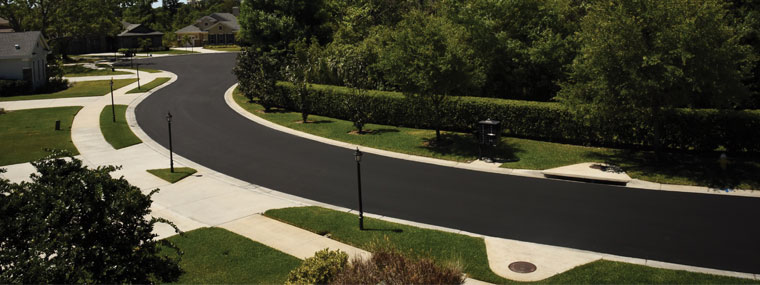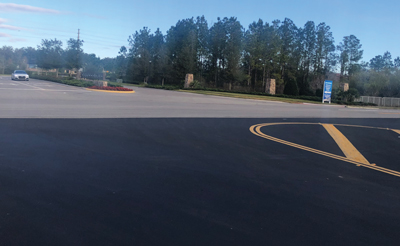
Slash Budgets for Street Maintenance
By Mark Beatty / Published December 2021

Most reserve studies for private associations identify the streets at or near the top of the list of their HOA budget plan. Understanding just a couple of concepts will significantly reduce the financial demands of this mega asset for your community.
Think for a minute about which board member you would prefer to be making decisions for your community’s next pavement management project…
Studly Stan: “We saved thousands with our street maintenance project!”
Savvy Susan: “We will save thousands with our street maintenance strategy!”
Both statements sound attractive. After being involved in this industry for 20-plus years, I’ve seen Studly Stans set up communities for some costly and painful special assessments. The priority when looking at preserving pavement assets is not looking at just the next six months, but the next 15–20 years. I’ve noticed that the average new HOA board member, and I shared this mindset before I was in this industry, has the perception that residential roads and parking areas will likely last a lifetime. The perception is that arterial, heavily trafficked roads will need repair, but residential streets receive less stress and therefore require less attention. One asphalt “fun fact,” if there is such a thing related to asphalt, is that often low-volume residential streets don’t get enough traffic, which can actually contribute to an asphalt pavement’s loss of lifespan.
You read that correctly. Low-volume residential streets experiencing very little traffic can become brittle and more susceptible to cracking quicker than streets with moderate traffic. This is because asphalt is a flexible pavement, and traffic “kneads” the pavement, for lack of a better word, by bringing the oils and resins to the surface.
I’ll move on from this asphalt “fun fact” and focus more on the differences of Studly Stan’s and Savvy Susan’s decisions. But the reason I bring it up is that there is a foundation of understanding that should be had by an HOA board before proposals for a project are solicited and especially before a proposal is accepted. If you’re in a situation—and most boards are—where having an orientation for your board specific to the parameters of low-cost pavement ownership strategy would benefit you, I can point you in the right direction. There are short orientations available from organizations with an approved curriculum from the Florida Department of Professional Regulation that provide a simple foundation to get you started. Email mark@holbrookasphalt.com with the subject “Guidance to Lower the Street Ownership Costs,” and I’ll direct you to an accredited advisor with an approved curriculum who can provide you with the strategy tips you need.
 If you go into your pavement maintenance project with the goal of getting bids to seal the pavement at the lowest cost, usually you are looking at the present and not actual life-cycle costs. Look at your maintenance project with the longer-term “cost of ownership” view. I recall a board member in another state after the board had implemented a new strategy that included HA5 high–density mineral bond, touting their largest reserve study cost item—streets—was no longer at the top of the budget list. With this strategy change, the reserve study was updated with adjusted costs. The community’s board president, Robert Rothwell, PhD, enthusiastically commented (when referring to streets on his reserve study), “Now it’s the fourth or fifth item” on the budget list. If you’re interested in receiving a video link to his insights after they changed their strategy, email mark@holbrookasphalt.com and request “Lower HOA Budget Video” in the subject line, and I’ll respond with Dr. Robert Rothwell’s video.
If you go into your pavement maintenance project with the goal of getting bids to seal the pavement at the lowest cost, usually you are looking at the present and not actual life-cycle costs. Look at your maintenance project with the longer-term “cost of ownership” view. I recall a board member in another state after the board had implemented a new strategy that included HA5 high–density mineral bond, touting their largest reserve study cost item—streets—was no longer at the top of the budget list. With this strategy change, the reserve study was updated with adjusted costs. The community’s board president, Robert Rothwell, PhD, enthusiastically commented (when referring to streets on his reserve study), “Now it’s the fourth or fifth item” on the budget list. If you’re interested in receiving a video link to his insights after they changed their strategy, email mark@holbrookasphalt.com and request “Lower HOA Budget Video” in the subject line, and I’ll respond with Dr. Robert Rothwell’s video.
Maybe a good analogy for Studly Stan and Savvy Susan’s situation is to compare their outlooks to the most famous race in Florida, the Daytona 500. If the winner of the race is equated to the lowest cost of ownership, we can look at things this way. Studly Stan’s excitement and focus is on who is winning the race after the first 50 miles. That doesn’t tell you much about who actually wins the race. That requires having the best strategy over 500 miles.
A proper strategy must incorporate the following:
- Timing—As pavement ages and changes condition, the best treatment option also changes. Understanding and incorporating the right timing into the strategy makes a significant impact on the total cost of ownership.
- Treatment Options—This can be the hardest to decipher. Turning a pavement black doesn’t always mean you’ve done something to effectively extend the pavement’s life. You must become aware of the pros and cons of various treatment types.
- Managing Cracks—There are climate conditions that are better than another to seal cracks, and there are also cracks that are a waste of money to be sealed.
Again, my encouragement for board members and community managers alike is to seek out an opportunity to learn more on pavement management strategy. If you would like a recommendation for a Florida Department of Professional Regulation approved orientation for your board, please contact me.
Mark Beatty
Senior Vice President, Holbrook Asphalt Company
Mark Beatty is on the Advisory Board for the International Pavement Management Association and consults with public agencies and HOAs throughout the U.S. He is a sought-after presenter at public works events as well as HOA seminars. Mark serves as the Sr. Vice President at Holbrook Asphalt Company. You can contact Mark at mark@holbrookasphalt.com.





